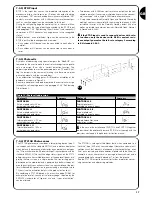
16
7.2.6) Level two programming example (adjustable parameters)
The example shows the sequence to follow to change the factory settings of parameters and increase the “Pause Time” to 60 seconds (input
on L1 and level on L5) and reduce the “Motor Torque” of 60% (input on L5 and level on L3).
1.
Press and hold
[Set]
(approx. 3 s)
3s
2.
Release
[Set]
when L1 LED starts flashing
L1
3.
Press and hold
[Set]
during steps 4 and 5
4.
Wait approx. 3 seconds until LED L3, representing the current level of the “Pause Time” will light up
L3
3s
5.
Press
[
▼
]
twice to move the LED which is lit to LED L5, which represents the new “Pause Time” value
L5
6.
Release
[Set]
7.
Press
[
▼
]
four times to move the flashing LED to LED L5
L5
8.
Press and hold
[Set]
during steps 9 and 10
9.
Wait approx. 3 seconds until LED L5, representing the current level of the “Motor Torque” will light up
3s
L5
10.
Press
[
▲
]
twice to move the LED which is lit to LED L3, which represents the new “Motor Torque” value
L3
11.
Release
[Set]
12.
Wait 10 seconds before leaving the programme to allow the maximum time to lapse.
10s
Table 12: Level two programming
Example
SET
SET
SET
SET
SET
SET
7.3) Adding or removing devices
Devices can be added to or removed from the RUN automation sys-
tem at any time. In particular, various devices types can be connect-
ed to “BlueBUS” and “STOP” input as explained in the following
paragraphs.
After adding or removing any devices, the automation sys-
tem must go through the self-learning process again
according to the directions contained in paragraph 7.3.6
“Device self-learning”.
7.3.1) BlueBUS
BlueBUS technology enables the connection of compatible devices
using only two wires which carry both the power supply and the
communication signals. All the devices are connected in parallel on
the 2 wires of the BlueBUS itself. It is not necessary to observe any
polarity; each device is individually recognized because a univocal
address is assigned to it during installation. Photocells, safety
devices, control keys, signalling lights etc. can be connected to
BlueBUS.
The RUN control unit recognizes all the connected devices individu-
ally through a suitable self-learning process, and can detect all the
possible abnormalities with absolute precision. For this reason, each
time a device connected to BlueBUS is added or removed, the con-
trol unit must go through the self-learning process; see paragraph
7.3.6 “Self-learning Other Devices”.
7.2.5) Level one programming example (ON-OFF functions).
The sequence to follow in order to change the factory settings of the functions for activating “Automatic Closing” (L1) and “Always close” (L3)
have been included as examples.).
1.
Press and hold
[Set]
(approx. 3 s)
3s
2.
Release the
[Set]
key when L1 LED starts flashing
L1
3.
Press
[Set]
once to change the state of the function associated with L1 (Automatic Closing).
LED L1 will now flash with long flashes.
L1
4.
Press
[
▼
]
twice to move the flashing LED to LED L3
L3
5.
Press the
[Set]
key once to change the state of the function associated with L3 (Always Close).
LED L3 will now flash with long flashes.
L3
6.
Wait 10 seconds before leaving the programme to allow the maximum time to lapse.
10s
Once these operations have been completed, LEDs L1 and L3 must remain on to indicate that the “Automatic Closing” and the “Always
Close” functions are active.
Table 11: Level one programming
Example
SET
SET
SET
SET






























